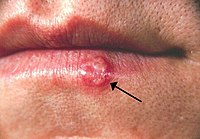
Photo from wikipedia
The aim of the present study was to assess the clinico-histopathological picture and to examine the recurrence of various localized hyperplastic gingival growths after their surgical treatment. Twenty patients of… Click to show full abstract
The aim of the present study was to assess the clinico-histopathological picture and to examine the recurrence of various localized hyperplastic gingival growths after their surgical treatment. Twenty patients of localized hyperplastic gingival outgrowth were evaluated in the present clinico-histopathological study. The data regarding age, sex, location, size, and duration of lesion were summarized. After 4 weeks of initial therapy, an excision of the growth with conventional flap surgery was performed. The excised tissues were sent for histopathological analysis, and the lesions were reclassified into four groups. All the patients were recalled after 3 and 6 months to study the recurrence of the growth. Twenty lesions were inspected, the pyogenic granuloma was the most common (55%), followed by peripheral fibroma (25%), peripheral giant cell granuloma (15%), and calcifying fibroblastic fibroma (5%). Out of the twenty lesions evaluated, the pyogenic granuloma was the most common with no recurrence in any case.
Journal Title: Journal of Indian Society of Periodontology
Year Published: 2017
Link to full text (if available)
Share on Social Media: Sign Up to like & get
recommendations!